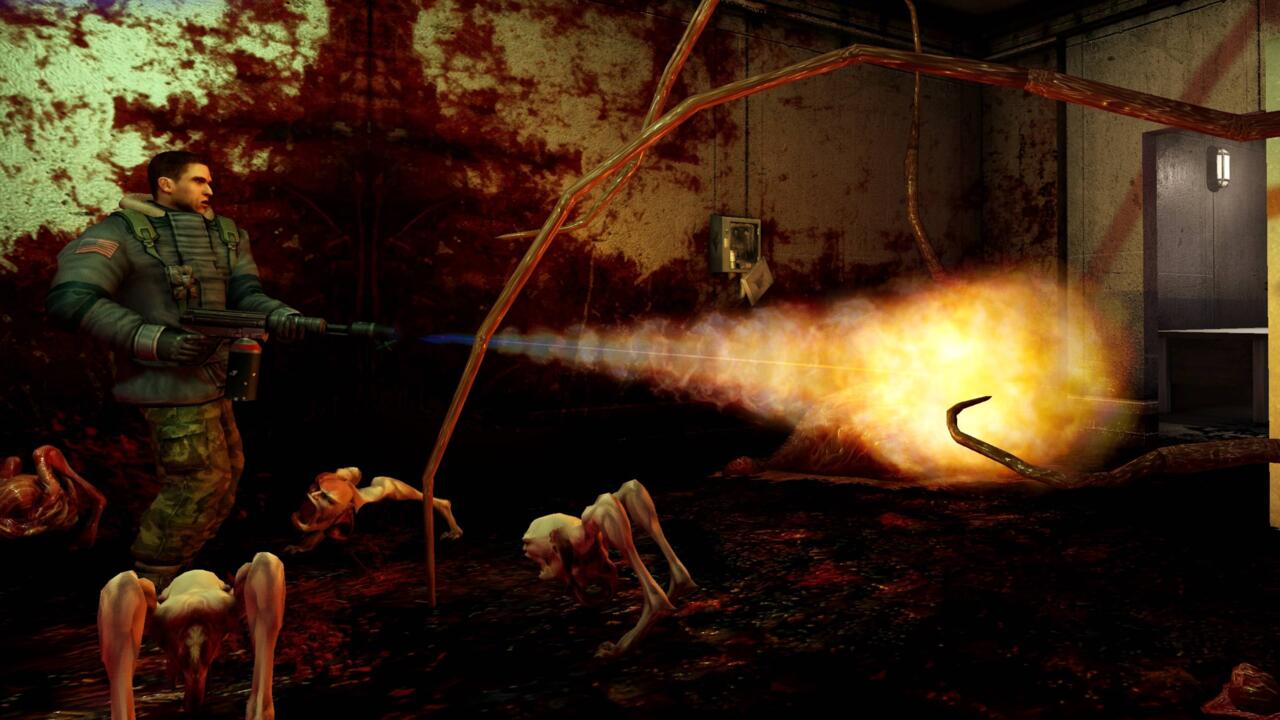For my money, there isn’t a better horror monster than The Thing’s shape-shifting alien organism. Even 42 years later, Rob Bottin’s practical effects are still incredible, capturing each freakish amalgamation of tentacles, sharp teeth, sinew, and traces of malformed humanity with ghastly clarity. I’ve seen The Thing dozens of times, yet seeing Norris’ decapitated head contort and grow arthropod-esque legs will never fail to twist my stomach in knots. These are the everlasting images of The Thing, but it’s the alien’s ability to perfectly imitate anyone that genuinely terrifies, permeating each scene with an unnerving sense of dread and paranoia that affects both its characters and the audience watching. Who do you trust when anyone could be a clandestine threat?
Back in 2002, developer Computer Artworks attempted to translate this feeling into an officially licensed video game for The Thing. The now-shuttered studio came close to succeeding, too, creating a third-person horror-action game with a unique squad system that ensured you could never entirely trust the person fighting by your side. It’s become somewhat of a cult classic since then, leading to this remaster from Nightdive Studios–a developer known for faithfully restoring myriad games, including Shadow Man and Star Wars: Dark Forces. The Thing: Remastered is a similarly authentic experience, albeit with a number of key improvements to the game’s visuals, controls, and some quality-of-life mechanics. Beyond this, it’s much the same game as it was in 2002, for both the good and the bad.

The game’s setup is one of its better aspects, acting as a direct sequel to John Carpenter’s iconic 1982 film. You play as the bland, one-dimensional Captain Blake, leader of a U.S. Special Forces rescue team sent to investigate Outpost 31 in the isolating tundra of Antarctica. Of course, we know what transpired when MacReady and the rest of this research facility encountered the shape-shifting alien life-form, and it doesn’t take long before Blake is fighting off all manner of horrific entities. He’s rather nonchalant about the whole thing, though, anchoring a relatively thin story that feels distinctly 2002 in all the worst ways. While it begins as a more action-oriented facsimile of the film it’s ostensibly a sequel to, the narrative quickly delves into predictable territory with the military experimenting on the Thing to use the alien for its own gain. It’s all very stereotypical, with melodramatic voice acting and–aside from a fun cameo from John Carpenter himself–an inherently disposable cast of characters.
Most of the people you meet are potential squad members. To survive The Thing: Remastered, earning and maintaining the trust of the surviving crew is paramount. By killing enemies and supplying each squadmate with weapons, ammo, and healing, they’ll happily fight alongside you. The twist is that this is The Thing, so you could be handing a weapon to an enemy interloper or someone paranoid enough to suspect you of being one yourself. Not only can your squad members be a Thing in disguise, but they also have the capacity to turn on you if their trust diminishes or they’re overcome by fear. They regularly experience anxiety, which spikes when witnessing traumatic events, such as seeing a dismembered corpse or a particularly grotesque alien. If they suffer from enough stress or lose your trust–because you accidentally shot them, didn’t take part in combat, and so on–they’ll crack and run away, kill themselves, or start shooting everyone around them, attempting to kill both you and your colleagues.
It’s a thoughtful implementation of the film’s tenants of trust, paranoia, and deception, with the potential to generate nail-biting tension through friend and foe alike. Suddenly, your squadmates are more than just simple NPCs; they’re people displaying real human behavior. It was an innovative concept back in 2002 when this kind of trust and fear management was unheard of. Even today, it’s not something I’ve seen implemented in other single-player games; typically, it’s reserved for social multiplayer experiences like Among Us instead.
The Thing: Remastered is [an] authentic experience, albeit with a number of key improvements to the game’s visuals, controls, and some quality-of-life mechanics. Beyond this, it’s much the same game as it was in 2002, for both the good and the bad
For the game’s first couple of hours, the way these ideas are executed is compelling. The Thing: Remastered immediately establishes an unsettling atmosphere as you begin exploring the dilapidated remnants of Outpost 31. Your teammates are already on edge even before you discover a flying saucer buried under the ice, with the howl of the Arctic’s bitingly cold wind and Ennio Morricone’s haunting score punctuating certain moments with another alluring layer of unease. Nightdive has done a fantastic job of updating the original game’s visuals, too, with improved character models, textures, and animations, as well as dynamic lighting and shadows to really spruce up the 22-year-old game. It still maintains the somewhat blocky look of a game from the PS2 era but smoothes over its rougher edges with modern techniques that make the visuals more palatable for a modern audience.
As you progress further into the game, you’ll come up against all manner of enemy creatures, from small four-legged scuttlers to more humanoid monstrosities with deadly claws and exposed innards. These larger enemies need to be damaged with small-arms fire before being set alight with either a flamethrower or incendiary grenade. Fortunately, Nightdive has altered the flamethrower so that it doesn’t burn you if you’re holding the trigger while simultaneously moving forward. Ammunition is also much more plentiful, preventing those instances in the original game where you would be forced to reload a save from hours before to try and conserve enough ammo for later. Aside from these welcome changes, combat in The Thing: Remastered feels much the same, utilizing a generous lock-on system that makes it easy to clear out rooms without much thought. It’s fine but hardly compelling.
Your teammates aren’t too shabby in a fight, at least, though their main purpose is often to open doors for you. The game’s level design is commonly built on gating your progression with broken junction boxes that prevent things like doors and computers from working. While you’re able to fix some of this damaged equipment, most of them require a specialized engineer, creating one of the first issues with the game’s notion that “anyone could be an alien.” If you require an engineer to progress, then their death or transformation simply results in a game over screen, removing the potential for the type of randomness that makes the game’s concept so enticing. The more you play, the more it’s revealed that The Thing: Remastered is essentially struggling under the weight of its own ambition. Certain squad members will become aliens at pre-determined points, no matter how carefully you’ve managed their trust and fear. Even if a blood test reveals that they’re still human mere seconds before, this is quickly rendered moot by the game’s rigid scripting.

As a result, The Thing: Remastered falters as a squad-based game because you’re never incentivized to care about anyone’s survival but your own. With the story dictating when certain characters will transform–and most teammates disappearing at the end of each level anyway–forming any sort of attachment to them is futile. There are no repercussions for trusting your teammates, either. Any weapons you give them are dropped when they transform, and keeping their trust up and fear down is a simple task, so I never felt like anyone would crack, which gradually chips away at the game’s tension. By the halfway point, Computer Artworks seemingly struggled to take the concept any further, turning the game into a boilerplate run-and-gun shooter that sees you fighting aliens and mindless human enemies alike. It’s a far cry from the game’s opening and makes for a banal slog towards a disappointing ending.
I have fond memories of playing The Thing back in 2002 because there wasn’t anything else quite like it. It was inventive and exciting, and even today, no one else is trying to do what Computer Artworks attempted in the single-player space. I commend the studio for what it achieved, but the limitations of the technology–and its design constraints–are much more apparent now, even with nostalgia-tinted glasses on. Nightdive has done a fantastic job of restoring this flawed but intriguing game, continuing its crucial work with game preservation. All of the changes it’s made are positive, resulting in a better game, both visually and mechanically. Nonetheless, this is a case where a complete remake would’ve been much more appealing, allowing for the trust and fear system to be fleshed out with less rigidity and more dynamism. As it is, Computer Artworks’ vision might never be fully realized, and that’s a shame.












Leave a Reply